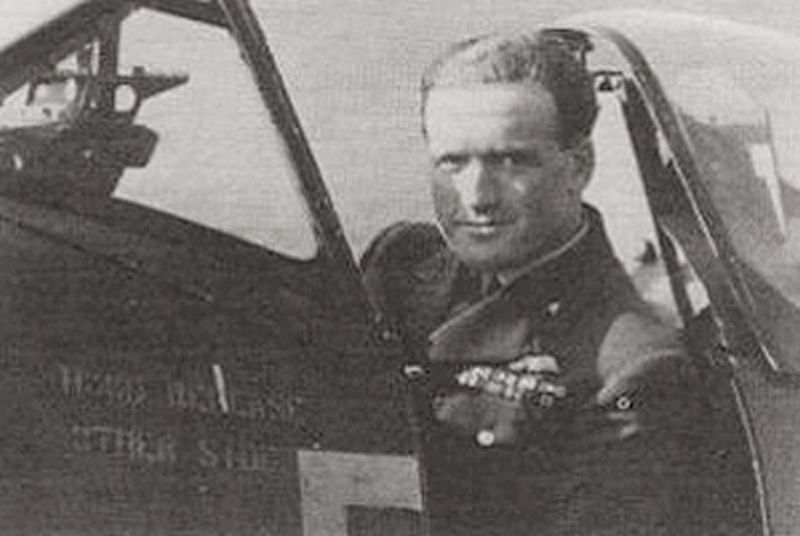Bamberger, Cyril Stanley "Bam"
- Date of birth:
- May 4th, 1919 (Hyde/Cheshire, Great Britain)
- Date of death:
- February 3rd, 2008 (Hyde/Hampshire, Great Britain)
- Nationality:
- British (1801-present, Kingdom)
Biography
Cyril "Bam" Bamberger was born on 4th May 1919 in Hyde, Cheshire. At the age of 14 years he left school and went working as an electrical apprentice with Lever Brothers in 1934. In 1936 he joined the Auxiliairy Air Force and was posted to No. 610 "County of Chester" Squadron as a photographer at Hooton Park Airfield. In 1938 he joined the pilot training course and was trained on the Supermarine Spitfire with No. 610 Squadron.
In July 1940 the Squadron was transferred to Biggin Hill and Sergeant Pilot Bamberger flew sorties over the Channel and was active during the evacuation of Dunkirk. On 28th August 1940 he was credited with a "probable" kill of a Messerschmitt Bf 109 just off the Kent coast. Mid-September, Bamberger was transferred to No. 41 Squadron and scored his first "confirmed" kill of another Bf 109 over Kent on 15th October. When the Battle of Britain faded out, Bamberger volunteered for Malta and went aboard the H.M.S. Argus to the Mediterranean, where it arrived on 17th November. The Argus only had Hawker Hurricanes and Blackburn Skua’s which were flown to Malta. Bamberger was not trained to fly these planes and stayed on the aircraftcarrier. The lesser experienced pilots were slaughtered on their way to Malta. Bamberger arrived safely in Malta on board the destroyer H.M.S. Hotspur in December. Here he joined No. 261 Squadron and went right into action. In January he shot down two Junkers Ju 87 Stuka’s over Grand Harbour on two successive days.
After his period on Malta he returned to the United Kingdom and was assigned to training newly arriving American pilots, but soon was sent back to the Mediterranean as Flight Commander with No. 93 Squadron. Here he participated in the Sicilian and Italian Campaigns, scoring several victories. Late 1944 he returned to the United Kingdom to serve as a Gunnery Instructor.
After his demobilisation he returned to his former work at Lever and later went working with the management of Guinness. In 1950 he rejoined the Royal Auxiliary Air Force as Commanding Officer of the reformed No. 610 Squadron, flying the Gloster Meteor. At the outbreak of the Korean War he accepted a permanent position and became Intelligence Officer with the Air Ministry. Later he was trained to fly helicopters and he flew the Bristol Sycamore in Aden. In 1954 he married Heather and he finally retired in 1959. For his service after the war he received the Air Efficiency Award and a Bar for his second award. He again went into business and founded a packaging materials company and later ran an antique business. Although retired from the RAF he stayed in close touch and was involved in the Bentley Priory Battle of Britain Trust as its vice-chairman.
Squadron Leader "Bam" Bamberger died on 3rd February 2008.
Service numbers
810024, Auxiliairy Air Force;
116515, Royal Air Force Volunteer Reserve.
Promotions:
1st October 1942: Flying Officer on probation.
Do you have more information about this person? Inform us!
- Period:
- Second World War (1939-1945)
- Rank:
- Flying Officer
- Unit:
- No. 93 Squadron, Royal Air Force
- Awarded on:
- September 28th, 1943
- Period:
- Second World War (1939-1945)
- Rank:
- Flight Lieutenant
- Unit:
- No. 243 Squadron, Royal Air Force
- Awarded on:
- November 14th, 1944
Second DFC received as a bar for on the ribbon of the first DFC.
- Period:
- Second World War (1939-1945)
- Period:
- Second World War (1939-1945)
- Period:
- Second World War (1939-1945)
- Period:
- Second World War (1939-1945)
- Period:
- Second World War (1939-1945)
- Period:
- Second World War (1939-1945)
Sources
- Photo 1: RAF
- - The Times-Obituaries
- Supplement to The London Gazette Issue 36187 published on the 24 September 1943
- Third Supplement to The London Gazette Issue 36793 published on the 10 November 1944
- Flight Global - Archive
- Battle of Britain | Bentley Priory Museum










